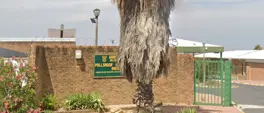Gold mining past poisons Soweto community, residents say
AFP
13 June 2025 | 8:53The yellow dust that blows off it stings the throat. Studies have found it contains traces of toxic substances such as arsenic, lead and uranium - a legacy of the 1880s gold rush that founded Johannesburg and Soweto.

Living close to highly toxic substances such as arsenic, lead and the radioactive element uranium is a daily reality for 15 to 20 million people in South Africa, according to David van Wyk, senior researcher at the Bench Marks Foundation, a South African non-governmental and religious organization. Photo: AFP
Soweto's children call it the "yellow mountain": for decades, a gold mine dump that towers over the Snake Park neighbourhood of South Africa's largest township has been polluting the area and poisoning communities.
The yellow dust that blows off it stings the throat. Studies have found it contains traces of toxic substances such as arsenic, lead and uranium - a legacy of the 1880s gold rush that founded Johannesburg and Soweto.
The local Snake Park Cerebral Palsy Forum has since 2017 documented at least 15 cases of children born with the condition. Many more have deformations and disabilities, it says.
Okuhle, 13, has cerebral palsy and was abandoned in the street as a baby. Sitting in a wheelchair next to her foster mother on a recent afternoon, the cheerful girl communicated with squeals.
“She can't walk, she can't speak ... she can't use her arms well,” said Lilly Stebbe, 60, who also blames the mine for the child's asthma, eye and sinus problems.
- Toxic pollution -
Stebbe herself struggled with a constant cough and irritated eyes. The dust went everywhere, she said.
"When you breathe that dust, it can give you all kinds of cancer," said David van Wyk, lead researcher at the Bench Mark Foundation, a watchdog of local business practices.
"It can also mix your DNA codes and your children will be born with all kinds of deformities," he said. "We find lots of ... physically challenged children in this community."
There are more than 6,000 abandoned mines across South Africa, according to the auditor-general. At least 2,322 are considered high-risk for the adjacent communities.
Van Wyk said between 15 and 20 million South Africans live near such toxic pollution. About 50,000 are in the small houses of Snake Park and more in shacks at the foot of the mine in an informal settlement called Mountain View.
Every month, van Wyk carries out tests on the dump, a vast expanse of powdery soil with a reddish stream through it, as part of a joint study with the University of Johannesburg.
- 'Ten years' -
The two-year study aims to measure and identify solids dissolved in the water. On this day, the testing device detected a concentration of 776 mgs of solids per litre. This made the water unfit for drinking, said van Wyk.
More importantly, the water "contains uranium and strontium, which are both radioactive," he said. The NGO has detected "a whole range of very toxic substances" from copper to arsenic and lead in the stream, he said.
It flows into nearby maize fields and surrounding pastures. Residents say some goats were born three-legged.
Local company Pan African Resources said it bought the mine in 2022 after the previous owner was liquidated without rehabilitating the site.
The pollution had been seeping out of the tailings for at least 50 years, the company told AFP.
"Give us maximum 10 years, we'll remove it completely," said community relations manager Sonwabo Modimoeng.
"We know that this affects people," he told AFP, adding the company had told people not to approach the area. It has also installed warning signs.
But these measures were insufficient for Thokozile Mntambo, who leads Bambanani, an NGO advocating for the rehabilitation of the area.
"The dump needs to be taken off right now, not after 10 years," she said. "Every day, the dust contaminates people."
- Community support -
Baile Bantseke, 59, lives a few hundred metres from the dump with her grandson Mphoentle. The five-year-old has been diagnosed with autism, which Bantseke blames on the "mountain".
Multiple studies, including one published in 2024 in the journal Environmental Health, have established links between autism and exposure to environmental pollutants like heavy metals.
"I blame our government. If they were looking after us, we would not be having such issues," Bantseke said.
Families with disabled children receive a monthly grant of 2,310 rands ($130), barely enough to afford food, clothes and diapers. It does not cover transport to a hospital 15 kilometres away where the children should get treatment.
"We don’t have wheelchairs, we don’t have pickup trucks," said Kefilwe Sebogodi, who founded the Snake Park Cerebral Palsy Forum and is raising a disabled niece.
In the run-down community hall, she welcomed a dozen mothers, grandmothers and caregivers joining the Forum's support group.
Their monthly meetings showed that "the children matter in this community", Sebogodi said. "We are still standing."
Get the whole picture 💡
Take a look at the topic timeline for all related articles.
Trending News
More in Local

29 October 2025 16:22
Deputy ministers under scrutiny after Deputy Police Minister Mathale admits not having delegated duties

29 October 2025 15:45
Magistrates demand action from President, salaries commission over 17-year salary stagnation

29 October 2025 15:14
POPCRU worried about safety of Correctional Services officials












